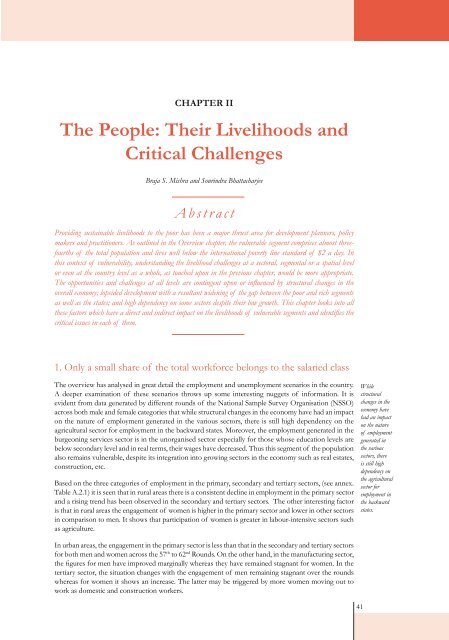SOIL Report 2008 - ACCESS Development Services
SOIL Report 2008 - ACCESS Development Services
SOIL Report 2008 - ACCESS Development Services
Create successful ePaper yourself
Turn your PDF publications into a flip-book with our unique Google optimized e-Paper software.
Chapter IIThe People: Their Livelihoods andCritical ChallengesBraja S. Mishra and Sourindra BhattacharjeeAbstractProviding sustainable livelihoods to the poor has been a major thrust area for development planners, policymakers and practitioners. As outlined in the Overview chapter, the vulnerable segment comprises almost threefourthsof the total population and lives well below the international poverty line standard of $2 a day. Inthis context of vulnerability, understanding the livelihood challenges at a sectoral, segmental or a spatial levelor even at the country level as a whole, as touched upon in the previous chapter, would be more appropriate.The opportunities and challenges at all levels are contingent upon or influenced by structural changes in theoverall economy; lopsided development with a resultant widening of the gap between the poor and rich segmentsas well as the states; and high dependency on some sectors despite their low growth. This chapter looks into allthese factors which have a direct and indirect impact on the livelihoods of vulnerable segments and identifies thecritical issues in each of them.1. Only a small share of the total workforce belongs to the salaried classThe overview has analysed in great detail the employment and unemployment scenarios in the country.A deeper examination of these scenarios throws up some interesting nuggets of information. It isevident from data generated by different rounds of the National Sample Survey Organisation (NSSO)across both male and female categories that while structural changes in the economy have had an impacton the nature of employment generated in the various sectors, there is still high dependency on theagricultural sector for employment in the backward states. Moreover, the employment generated in theburgeoning services sector is in the unorganised sector especially for those whose education levels arebelow secondary level and in real terms, their wages have decreased. Thus this segment of the populationalso remains vulnerable, despite its integration into growing sectors in the economy such as real estates,construction, etc.Based on the three categories of employment in the primary, secondary and tertiary sectors, (see annex.Table A.2.1) it is seen that in rural areas there is a consistent decline in employment in the primary sectorand a rising trend has been observed in the secondary and tertiary sectors. The other interesting factoris that in rural areas the engagement of women is higher in the primary sector and lower in other sectorsin comparison to men. It shows that participation of women is greater in labour-intensive sectors suchas agriculture.Whilestructuralchanges in theeconomy havehad an impacton the natureof employmentgenerated inthe varioussectors, thereis still highdependency onthe agriculturalsector foremployment inthe backwardstates.In urban areas, the engagement in the primary sector is less than that in the secondary and tertiary sectorsfor both men and women across the 57 th to 62 nd Rounds. On the other hand, in the manufacturing sector,the figures for men have improved marginally whereas they have remained stagnant for women. In thetertiary sector, the situation changes with the engagement of men remaining stagnant over the roundswhereas for women it shows an increase. The latter may be triggered by more women moving out towork as domestic and construction workers.41














